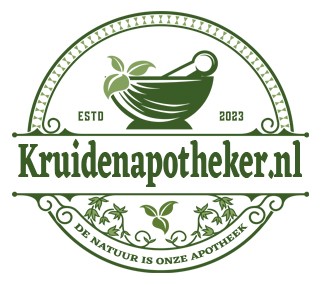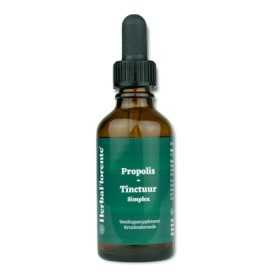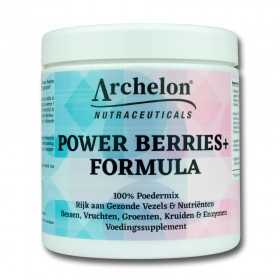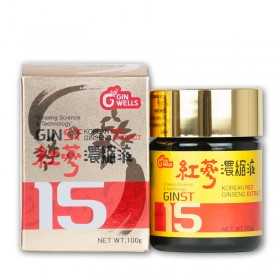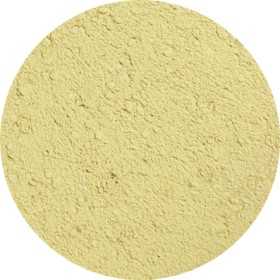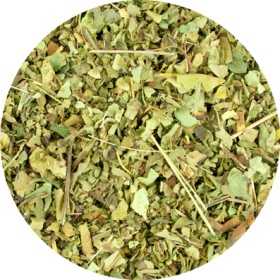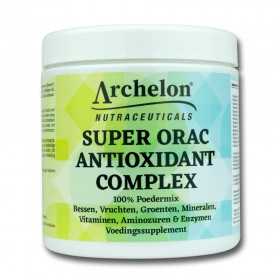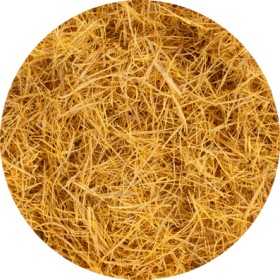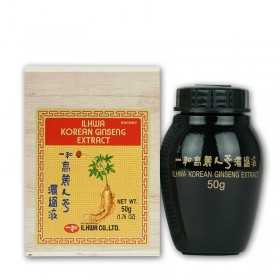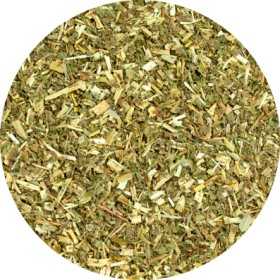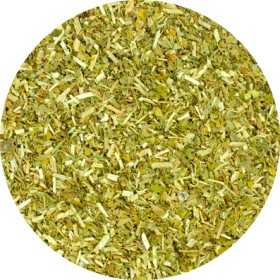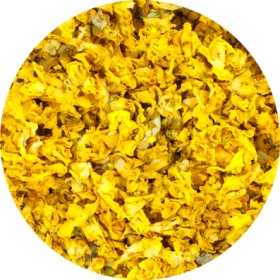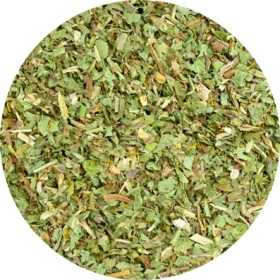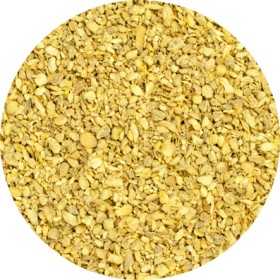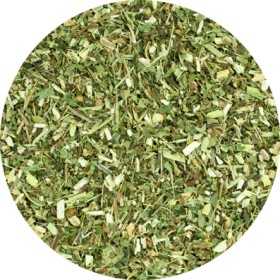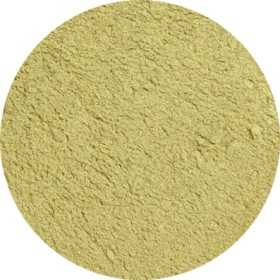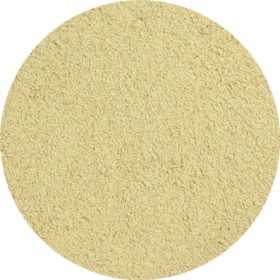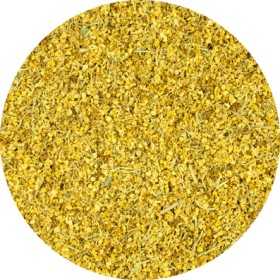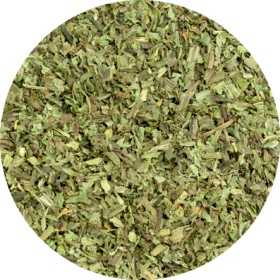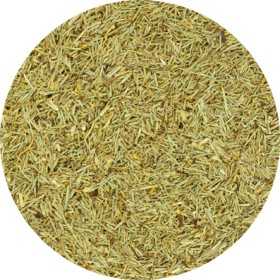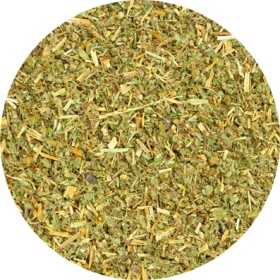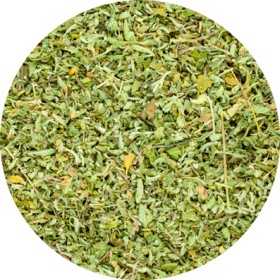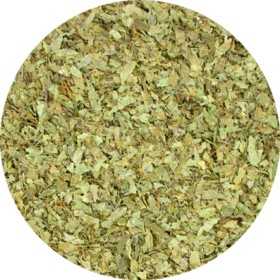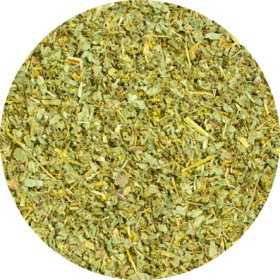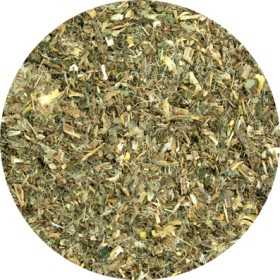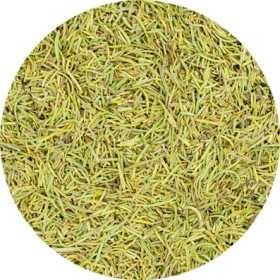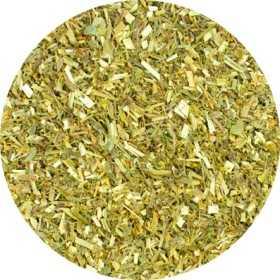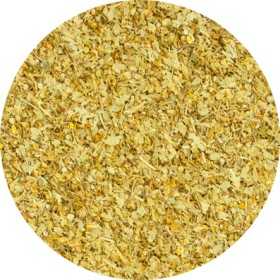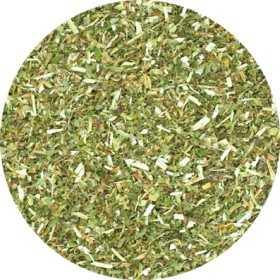Best sellers
There are 392 products.
Meadowsweet - Filipendulae ulmaria
The meadowsweet (Filipendula ulmaria) is a perennial plant belonging to the rose family (Rosaceae). It is an erect plant that can reach a height of 0.6 to 2 meters. The flowers of the meadowsweet are numerous and cream-colored, with a width of 0.4 to 1 cm and each consisting of five petals, which have a strong almond scent. The leaves are pinnately compound, with a large top leaflet that is palmately split.
In the past, meadowsweet was used as a remedy for biliary and kidney diseases, as well as for gout and nerve pain. The dried leaves and flowers were used to make tea, which was given for fever.
In the past, meadowsweet was used as a remedy for biliary and kidney diseases, as well as for gout and nerve pain. The dried leaves and flowers were used to make tea, which was given for fever.
€2.00
From: €2.00
Passionflower - Passiflora incarnata
Passionflower (Passiflora incarnata) is known as a traditional herb that has long been used to reduce stress and inner turmoil. Native people of Central and North America used various parts of the plant to relax and sleep better. It is a natural sedative.
Although the blue passion flower originally only grew in America, it can now be found almost everywhere. The flowers of the Passiflora incarnata are not only beautiful to look at, but also edible. In the fall, passion fruits grow and the leaves are also edible. These leaves are rich in tannins, flavanols, saponins, choline and magnesium.
Although the blue passion flower originally only grew in America, it can now be found almost everywhere. The flowers of the Passiflora incarnata are not only beautiful to look at, but also edible. In the fall, passion fruits grow and the leaves are also edible. These leaves are rich in tannins, flavanols, saponins, choline and magnesium.
€2.40
From: €2.40
Mullein - Verbascum thapsus
The mullein (Verbascum thapsus) is a member of the marram family (Scrophulariaceae) and mainly thrives in dune and chalk areas, where it is quite common. This plant is rare to find elsewhere in the Netherlands.
The flowers of the mullein are yellow and have a diameter of 1.5–3 cm. They consist of five connate petals, five sepals and five stamens, three of which are covered with yellow or white hairs. The flowers grow in dense spikes and bloom from July to autumn. An adult plant can reach a height of more than two meters.
The flowers of the mullein are yellow and have a diameter of 1.5–3 cm. They consist of five connate petals, five sepals and five stamens, three of which are covered with yellow or white hairs. The flowers grow in dense spikes and bloom from July to autumn. An adult plant can reach a height of more than two meters.
€5.00
From: €5.00
Dandelion (Herb) - Taraxum officinale - Cut
Dandelion (Taraxacum officinale) has been known for centuries for its ability to support liver and gallbladder function. Both the root and the above-ground parts of the plant are rich in nutrients. In addition, dandelion has a beneficial effect on digestion.
The rich nutritional value of dandelions makes it advisable to regularly pick some fresh leaves in the wild and add them to salads. They are especially tasty in the spring. The fresh yellow flowers can be used as a cheerful decoration in salads and dried they can be processed into a 'wild' herbal tea.
Dandelions contain a high level of bitter substances, which always indicates that they are beneficial for liver and gallbladder function.
The rich nutritional value of dandelions makes it advisable to regularly pick some fresh leaves in the wild and add them to salads. They are especially tasty in the spring. The fresh yellow flowers can be used as a cheerful decoration in salads and dried they can be processed into a 'wild' herbal tea.
Dandelions contain a high level of bitter substances, which always indicates that they are beneficial for liver and gallbladder function.
€2.20
From: €2.20
Ginger - Zingiberis Thiz. Mund. officinalis - Cut
Ginger comes from the root of the ginger plant (Zingiber officinale) and is used as a spice in many countries because of its strong flavor. It contains various bioactive substances, including gingerol, shogaol and zingiberene. Ginger supports the immune system, promotes healthy digestion and has a beneficial effect on the heart and blood vessels. Additionally, ginger can promote well-being during vehicle travel.
€2.40
From: €2.40
Echinacea (Coneflower) (Herb) - Echinaceae purp.
Purple coneflower (Echinacea purpurea) is one of the most widely grown and used herbs in the world because of its positive influence on the immune system. The genus name 'echinacea' is derived from the Greek word 'echinos', meaning 'hedgehog', because of the spiky flower cone. Since the beginning of the last century, much research has been done into Echinacea purpurea in Europe.
This plant has a rich history and originally comes from North America. Indigenous tribes used this perennial plant for its beneficial effects on the immune system. Colonist doctor H.C.F. Meyer adopted this knowledge from the indigenous population and brought the first product based on echinacea onto the market in 1871.
This plant has a rich history and originally comes from North America. Indigenous tribes used this perennial plant for its beneficial effects on the immune system. Colonist doctor H.C.F. Meyer adopted this knowledge from the indigenous population and brought the first product based on echinacea onto the market in 1871.
€2.00
From: €2.00
Wormwood Herb - Artemisia absinthium
Absinthe wormwood (Artemisia absinthium) is a plant from the composite family (Asteraceae). This species is on the Dutch Red List of plants as quite rare and moderately reduced in numbers. It is a perennial plant that grows naturally on dry, calcareous, nitrogen-rich and cultivated soils in temperate regions of Europe, Asia and North Africa. The genus name Artemisia is derived from the Greek hunting goddess Artemis.
The buds of wormwood absinthe are traditionally seen as medicinal. The bitter extract of these buds is an important ingredient in drinks such as vermouth and classic absinthe. The most important flavorings are absinthine and the menthol-smelling terpene thujone.
The buds of wormwood absinthe are traditionally seen as medicinal. The bitter extract of these buds is an important ingredient in drinks such as vermouth and classic absinthe. The most important flavorings are absinthine and the menthol-smelling terpene thujone.
€2.00
From: €2.00
Slippery Elm - Ulmi pubescent - Ulmus rubra
The Slippery elm (Ulmus rubra), also known as slippery elm, was initially mistaken for the Ulmus americana in 1753. It was not until 1793 that researchers discovered that it was a different species and gave it the name Ulmus rubra. This deciduous tree is mainly found in the humid highlands east of North America.
The slippery elm has traditionally had many uses in America. The tree grows quickly and produces durable wood that does not rot quickly. The strong fibers are often used to make thread or rope and are even suitable for clothing production.
The inner bark of the slippery elm is slimy and is often used to make tea. The dried and ground leaves are also used as tea.
The slippery elm has traditionally had many uses in America. The tree grows quickly and produces durable wood that does not rot quickly. The strong fibers are often used to make thread or rope and are even suitable for clothing production.
The inner bark of the slippery elm is slimy and is often used to make tea. The dried and ground leaves are also used as tea.
€9.30
From: €9.30
Marshmallow (Leaf) - Altheae officinalis
Marshmallow (Althaea officinalis) belongs to the mallow family (Malvaceae) and has been spread worldwide by human activity, especially to areas with suitable soil, humidity and climate.
The starch in the carrot, mixed with proteinaceous substances, was formerly used in making marshmallows and bacon. The leaves can be eaten cooked and the flowers can be used raw in salads.
Marshmallow root has a soothing effect on the respiratory tract (source WHO) and is used in cough syrups.
The starch in the carrot, mixed with proteinaceous substances, was formerly used in making marshmallows and bacon. The leaves can be eaten cooked and the flowers can be used raw in salads.
Marshmallow root has a soothing effect on the respiratory tract (source WHO) and is used in cough syrups.
€2.00
From: €2.00
Detox (Blood-Liver-Kidney) Herbal Tea
Herbal tea composed of various herbs
Support for detox, Blood, Liver and Kidneys
Support for detox, Blood, Liver and Kidneys
€3.95
Great Burdock - Arctium lappa
Also called burdock root. Great burdock is used in various ways, mainly for its beneficial effects on the skin. It is known for its ability to maintain the normal structure, elasticity and appearance of the skin from within. In addition, burdock root provides support to the immune system and contributes to healthy digestion. Discover the power of this remarkable plant now.
The burdock root thrives best in moist, nitrate-rich soils, preferably in the sun or light shade and in a temperate climate. You can mainly find burdock near houses and fields, on ruins, roadsides, wastelands, clearings in forests, at the edge of forests and in hedges. The root can grow more than a meter long.
The burdock root thrives best in moist, nitrate-rich soils, preferably in the sun or light shade and in a temperate climate. You can mainly find burdock near houses and fields, on ruins, roadsides, wastelands, clearings in forests, at the edge of forests and in hedges. The root can grow more than a meter long.
€2.50
From: €2.50
Elder - Sambuci nigri
The elder (Sambucus nigra L.) is a native tree/shrub in the Netherlands that is widespread in various places in our country. Towards the end of May the elder tree blooms and produces large umbels of small, creamy white flowers that give off a sweet, floral scent. These blossoms are used to make elderflower liqueur, syrup or pancakes. In addition to their delicious taste, the blossoms are also rich in substances, including up to 3% flavonoids such as rutin, quercetin and astragalin. In addition, they contain tannins (tannins), triterpenes, fatty acids and essential oil.
€3.60
From: €3.60
Ribwort Plantain - Plantaginis lanceolata - Cut
Narrow plantain (Plantago lanceolata) is a native plant that thrives in Europe, parts of Asia, North Africa and North America. The young leaves of this plant contain a rich mix of beneficial substances, including mucilages, tannins, bitter substances, flavonoids and minerals such as potassium and zinc. Best known for its soothing effect on the throat thanks to its mucilages, plantain also provides support for the immune system and promotes normal intestinal function. In addition, it can help maintain flexible joints and is beneficial for the liver.
€2.00
From: €2.00
Field Horsetail - Equisetum arvense - Cut
Horsetail (Equisetum arvense), also known as horsetail because of its appearance, belongs to the horsetail family. It is known for its supportive properties for the skin, hair and nails, and it provides benefits for the liver and blood vessels. Horsetail extract has a natural calming effect and promotes a healthy moisture balance.
This plant thrives in different environments, such as meadows, along roads, on waste land and on slopes. Horsetail is one of the oldest plant species on earth, having existed for 390 million years. Thanks to its deep roots, horsetail can extract minerals from the depths of the earth. That is why horsetail is packed with valuable substances, including minerals, fiber and silicon.
This plant thrives in different environments, such as meadows, along roads, on waste land and on slopes. Horsetail is one of the oldest plant species on earth, having existed for 390 million years. Thanks to its deep roots, horsetail can extract minerals from the depths of the earth. That is why horsetail is packed with valuable substances, including minerals, fiber and silicon.
€3.95
From: €3.95
Agremonie (Common) (Church Steeples) - Agrimonia eupatoria
The common agrimony (Agrimonia eupatoria) is a herbaceous plant belonging to the rose family (Rosaceae). This plant, with its bright yellow flowers in long, slender spikes, is quite common on calcareous roadsides and dikes in Belgium and the Netherlands.
In herbal medicine, this plant is used for various purposes due to its active constituents, including triterpenes, tanning and bitter substances, flavonoids, silicic acid and mucilages.
The most common use is as a tea, but the herb can also be made into a tincture.
In herbal medicine, this plant is used for various purposes due to its active constituents, including triterpenes, tanning and bitter substances, flavonoids, silicic acid and mucilages.
The most common use is as a tea, but the herb can also be made into a tincture.
€2.00
From: €2.00
Damiana - Damianae mex. (Turnera diffusa) - Cut
Damiana (Turnera diffusa) is a shrub native to southern Texas in the United States, as well as Central America, Mexico, South America and the Caribbean. It belongs to the Passifloraceae family and has been used by the Mayan Indians for centuries for its known effects on libido. Both men and women benefit from the libido-supporting properties of damiana, which is also known for its stress-reducing effect.
In Mexico, women often prepare tea from the fragrant leaves of the damiana shrub or smoke them to stimulate their feelings of pleasure. Damiana leaf contains several active substances, including beta-sitosterol, arbutin and alkaloids.
In Mexico, women often prepare tea from the fragrant leaves of the damiana shrub or smoke them to stimulate their feelings of pleasure. Damiana leaf contains several active substances, including beta-sitosterol, arbutin and alkaloids.
€4.60
From: €4.60
Asian Pennywort (Gotu kola) - Hydrocotyles Folium (Centella asiatica)
Asian pennywort also known as Gotu kola(Centella asiatica), is a plant that thrives in Southeast Asia and plays a central role in Ayurvedic medicine. Due to its diverse active substances, Asian pennywort is widely used in herbal medicine. It is known for supporting cognitive functions such as memory, concentration and learning, and it is also used to promote healthy blood circulation and vascular function.
Asian pennywort is a delicate plant with creeping stems and small, rounded leaves, often accompanied by white or pink flowers. The main bioactive compounds in Asian pennywort are triterpene glycosides, alkaloids and essential oils.
Asian pennywort is a delicate plant with creeping stems and small, rounded leaves, often accompanied by white or pink flowers. The main bioactive compounds in Asian pennywort are triterpene glycosides, alkaloids and essential oils.
€3.50
From: €3.50
Lady's Mantle - Alchemilla vulgaris
Lady's mantle (Alchemilla vulgaris) is a genus of about a thousand species of perennial herbaceous and shrubby plants belonging to the rose family (Rosaceae). It is mainly found in Europe and Asia, with some species in the mountainous areas of Africa, North and South America. Lady's mantles thrive in disturbed and usually damp places, such as forest edges, wet grasslands and roadsides.
€2.50
From: €2.50
Calcium Bisglycinate - 480 mg
Calcium is available in different forms, one of the better forms being calcium bisglycinate. Calcium bisglycinate has good bioavailability. It is a chelated form of calcium bound to two (bis) molecules of the amino acid glycine, which has more benefits for the body. Calcium is also involved in many body processes, including blood clotting, energy metabolism, muscles, bones, teeth, digestion, nervous system and cell division.
Today, many minerals are available in their inorganic form as nutritional supplements, such as oxides, carbonates and sulphates. However, these forms are poorly absorbed by our body. In nature, minerals occur in bioavailable forms, packaged in proteins, to prevent them from binding to other food components. This significantly increases their bioavailability.
Today, many minerals are available in their inorganic form as nutritional supplements, such as oxides, carbonates and sulphates. However, these forms are poorly absorbed by our body. In nature, minerals occur in bioavailable forms, packaged in proteins, to prevent them from binding to other food components. This significantly increases their bioavailability.
€23.95
Milk Thistle (Herb) - Sylibum marianum, Cardui Mariae - Cut
Milk thistle (Silybum marianum), also known as milk thistle or milk thistle, is a spiny plant native to the Mediterranean region, but which also grows in our area. It belongs to the composite family. Milk thistle has been used for centuries as a natural remedy to support liver and bile function. It can be used as part of a cleansing regimen to assist the liver in the detoxification process.
€2.00
From: €2.00
Rosemary - Rosmarini officinalis - Cut
Rosemary (Rosmarinus officinalis L.) is a fragrant, compact shrub belonging to the Lamiaceae family. This versatile herb has been used for centuries for various purposes, both culinary and for health promotion. Originally from Mediterranean regions, the Rosmarinus officinalis displays lush blooms in spring with small, lavender blue flowers.
The name "rosemary" has its origins in the Latin "ros" (roris), meaning "dew", and "marinus", meaning "sea": "dew of the sea". Since ancient times, by both the ancient Greeks and Romans, Rosmarinus officinalis has been valued for its health-supporting properties. It helps with digestion, strengthens the immune system and contains antioxidants.
The name "rosemary" has its origins in the Latin "ros" (roris), meaning "dew", and "marinus", meaning "sea": "dew of the sea". Since ancient times, by both the ancient Greeks and Romans, Rosmarinus officinalis has been valued for its health-supporting properties. It helps with digestion, strengthens the immune system and contains antioxidants.
€2.00
From: €2.00
Yellow Sweet Slover - Melilotus officinalis
The Yellow Sweet Slover (Melilotus officinalis) is a biennial or perennial plant from the legume family (Leguminosae). Originally from Southern Europe, this plant has now spread worldwide. It is a slender, hairless plant that is frequently found along roads and on arable land, and is also found in dune areas. The lemon yellow honey clover reaches a height of 30 to 150 cm and blooms from July to October.
€2.00
From: €2.00
Lime tree Blossom - Tiliae officinalis
The lime tree (Tilia) is native to the Benelux and is known for its remarkable lifespan, which can easily exceed 1000 years. This majestic tree can reach a height of 20 to 30 meters, depending on its growing conditions. The Latin name for the lime tree is Tilia.
Although the lime tree is widespread in Europe, it is not found in the northernmost and southernmost parts of the continent. Outside Europe, the lime is also found in parts of Asia, but to a much lesser extent.
The tree blooms in the months of June and July. The lime blossom produces a lot of honey, and the flowers can be used to make herbal tea.
Although the lime tree is widespread in Europe, it is not found in the northernmost and southernmost parts of the continent. Outside Europe, the lime is also found in parts of Asia, but to a much lesser extent.
The tree blooms in the months of June and July. The lime blossom produces a lot of honey, and the flowers can be used to make herbal tea.
€5.00
From: €5.00
Heartwort - Leonurus cardiaca
Heartwort (Leonurus cardiaca) is a fragrant perennial plant that belongs to the Lamiaceae family. Originating in Central Asia, this plant has spread throughout the world.
The leaves are suitable for seasoning pea and lentil soup, and were also used in the past to brew beer. This plant has been used for centuries for its medicinal properties for heart problems and muscle cramps.
The plant grows to a height of 30-90 cm and forms rhizomes and square stems with scattered hairs. The leaves, which are medium green in color, have three to seven lobes and are downy hairy on the underside.
The leaves are suitable for seasoning pea and lentil soup, and were also used in the past to brew beer. This plant has been used for centuries for its medicinal properties for heart problems and muscle cramps.
The plant grows to a height of 30-90 cm and forms rhizomes and square stems with scattered hairs. The leaves, which are medium green in color, have three to seven lobes and are downy hairy on the underside.
€2.00
From: €2.00
